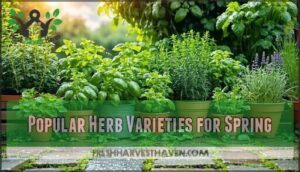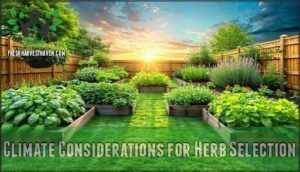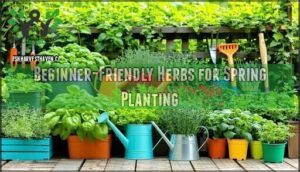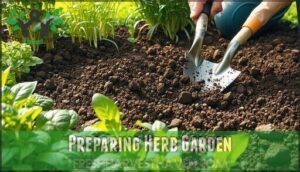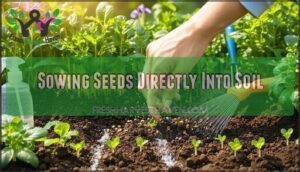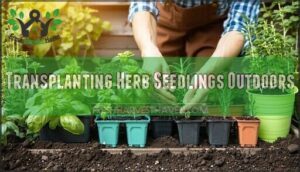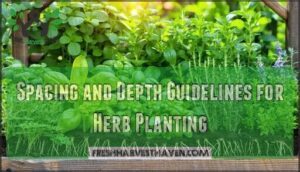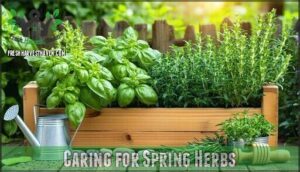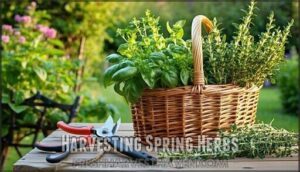This site is supported by our readers. We may earn a commission, at no cost to you, if you purchase through links.
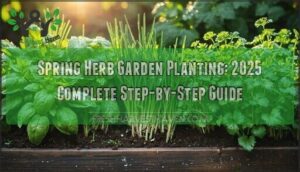
You can direct sow seeds or transplant seedlings once nighttime temps stay above 50°F. Space herbs according to their mature size and water deeply but less frequently.
Mediterranean herbs like rosemary and oregano need soil that drains fast—think sandy or rocky conditions. But herbs like parsley and chives? They’re fine with richer, slightly moister ground.
Here’s what really makes the difference: knowing when and how much to water each type.
Table Of Contents
- Key Takeaways
- Choosing Spring Herbs
- Preparing Herb Garden
- Planting Spring Herbs
- Caring for Spring Herbs
- Harvesting Spring Herbs
- Frequently Asked Questions (FAQs)
- When to start planting herbs for spring?
- What herbs grow best in spring?
- Which herbs should not be planted together?
- What herbs can I plant in May?
- What is the best layout for an herb garden?
- Can herbs survive unexpected late spring frosts?
- Should I use organic or synthetic fertilizers?
- How do I prevent herbs from cross-pollinating?
- When should I start herb seeds indoors?
- Can I plant different herbs together successfully?
- Conclusion
Key Takeaways
- Start your herb garden after nighttime temperatures stay above 50°F by choosing easy varieties like basil, chives, and cilantro that match your climate zone and cooking habits.
- Prepare well-draining soil with a pH between 6.0-7.0 by mixing in 2-3 inches of compost—herbs hate soggy conditions that cause root rot.
- Space herbs properly based on their mature size and plant at correct depths, giving compact herbs like cilantro 4-6 inches apart while larger ones like rosemary need 18-24 inches.
- Harvest regularly in the early morning when essential oils peak, cutting above leaf nodes to encourage continued growth and prevent plants from going to seed.
Choosing Spring Herbs
You’ll find success in spring herb gardening starts with picking the right varieties that match your growing conditions and cooking habits. Consider your local climate and available space, and think about which herbs you’ll actually use in the kitchen—there’s no point growing cilantro if your family thinks it tastes like soap!
Popular Herb Varieties for Spring
When you’re designing Herb Garden Designs for spring, you’ll want to pick varieties that thrive in cooler weather. Basil works best in warm spots, while Chives handle chilly mornings like champions.
Thyme and Cilantro are your go-to Spring herbs for Fragrant Herbs that’ll kickstart your Spring Herb Care routine. These powerhouses also shine in Herb Companion Planting and offer impressive Medicinal Herb Uses.
Climate Considerations for Herb Selection
Once you’ve picked your spring herbs, you’ll need to match them with your climate zones. Your plant hardiness zones and regional weather patterns determine which herbs will thrive. Check these three key factors:
- Temperature zones – Mediterranean herbs need frost tolerance above zone 7
- Soil moisture patterns from spring rainfall in your area
- Full sun availability – most herbs need 6+ hours daily
Climate resilience beats wishful thinking every time. Many herbs thrive with minimal care needed. Well-draining soil matters more than you’d think.
Beginner-Friendly Herbs for Spring Planting
Start your beginner herb garden with Easy Herb Choices like basil, chives, and parsley – these Low-Maintenance Options practically grow themselves.
Quick Growing Herbs such as cilantro and dill offer Best Flavor Profiles within weeks.
Kid-Friendly Herbs like mint make Spring gardening fun for families. These Spring herbs are perfect for Growing herbs at home and Planting herbs success.
Preparing Herb Garden
You’ll set the foundation for your herb garden’s success by creating the right growing conditions before you plant a single seed.
Good soil prep is like laying a solid foundation—get it right and your herbs will thrive with amazing flavor all season.
Soil Requirements for Spring Herbs
You’ve picked your spring herbs—great! But here’s the thing: your soil makes or breaks everything.
Get the foundation wrong, and even the hardiest herbs will struggle. Most herbs want that sweet spot between 6.0–7.0 pH, where they can actually grab the nutrients they need.
Most herbs thrive in soil pH between 6.0-7.0, which allows best nutrient absorption. Test your soil first—you can’t fix what you don’t measure. Well-draining soil prevents root rot, the number one killer of herb gardens.
Think of soil preparation like making a perfect cake—you need the right ingredients mixed properly. Adding organic matter transforms average dirt into herb paradise. Work in 2-3 inches of compost to improve both drainage needs and nutrient levels.
Just like baking requires the right ingredients mixed properly, transforming average dirt into herb paradise means working 2-3 inches of compost deep into your soil
Your soil conditions directly impact plant health, so don’t skip these soil amendments:
- Test and adjust soil pH using lime or sulfur as needed
- Mix compost 6-8 inches deep for better drainage
- Remove rocks and break up compacted areas thoroughly
Proper soil preparation sets you up for a thriving herb garden all season long.
Container Selection for Small Spaces
Once you’ve nailed down your soil needs, container selection for small spaces becomes your next key factor. Your spring herb garden planting success hinges on smart container materials and space optimization strategies.
Container Materials matter more than you think. Terra cotta breathes well but dries quickly, while plastic retains moisture longer. Ceramic containers offer style but can crack in temperature swings.
| Container Type | Best For | Size Range |
|---|---|---|
| Terra Cotta | Oregano, Thyme | 6-8 inches |
| Plastic | Basil, Cilantro | 8-12 inches |
| Ceramic | Decorative herbs | 6-10 inches |
| Wood | Large herbs | 12+ inches |
| Metal | Urban gardens | 8-14 inches |
Vertical gardening transforms cramped spaces into productive urban gardens. Wall-mounted small planters and tiered stands increase growing area while keeping herbs accessible.
Your herb gardening success depends on matching pot size to plant appetite. Small herbs like thyme thrive in 6-8 inch containers, while basil demands 12+ inch pots for proper root development. Container gardening lets you create productive gardens anywhere.
Sunlight and Watering Needs for Herbs
Getting your sunlight requirements and watering schedules right makes all the difference in your spring herb success. Most herbs crave full sun—that’s six solid hours daily—while soil moisture balance keeps roots happy without drowning them.
Here’s your game plan:
- Test soil drainage by checking if water flows freely through welldraining soil
- Monitor herb hydration levels, especially for thirsty varieties like basil
- Adjust light exposure and water timing based on each herb’s unique needs
Perfect drainage prevents soggy disasters.
Planting Spring Herbs
Time to get your hands dirty with the actual planting. You’ve got your space ready—now comes the fun part.
Sowing those tiny basil seeds or moving store-bought cilantro from pot to ground might seem straightforward, but spacing and depth make all the difference. Get it right, and you’ll have thick, fragrant herbs that actually taste like something. Get it wrong, and you’ll wonder why your plants look sad and sparse.
Sowing Seeds Directly Into Soil
Direct sowing creates sturdy root systems and saves money on starter plants. Once your soil preparation is complete, you’re ready for seed selection and proper sowing techniques.
Here’s your direct sowing roadmap:
- Test soil temperature – Wait until it hits 50-60°F for ideal germination rates
- Create shallow furrows using your finger, matching recommended seed depth on packets
- Space seeds properly to prevent overcrowding in your spring herb garden planting
- Water gently with a misting spray to avoid displacing seeds in well-draining soil
Thin seedlings once they emerge.
Transplanting Herb Seedlings Outdoors
Your seedlings are ready for the big move after mastering direct seeding. Hardening off readies these tender plants for outdoor life through outdoor acclimation.
Start seedling care one week before transplant timing by placing containers outside for increasing hours daily. Choose your garden placement when soil stays above 60°F consistently.
Transplanting herb seedlings outdoors into your spring herb garden planting requires gentle handling and proper soil preparation for successful herb garden establishment.
Spacing and Depth Guidelines for Herb Planting
After transplanting your seedlings, spacing becomes your secret weapon for healthy herbs. Proper Herb Planting Depths and Plant Spacing Rules prevent soil compaction while promoting a sturdy root system analysis.
Your garden layout planning depends on each herb’s growth pattern:
- Compact herbs: Plant cilantro, parsley, and chives 4-6 inches apart in well-draining soil.
- Medium spreaders: Space basil, thyme, and oregano 8-12 inches apart with a 6-inch planting depth.
- Large varieties: Give rosemary and sage 18-24 inches of breathing room to prevent overcrowding.
Dense plantings starve roots of nutrients and create disease-prone conditions. Your spring herb garden planting succeeds when each plant has adequate soil volume for root expansion. Follow these Spacing and Depth Guidelines for Herb Planting, and you’ll harvest abundantly all season long.
Caring for Spring Herbs
Your spring herbs are in the ground—time to learn the care basics that’ll keep them happy through the growing season.
You’ll need to balance proper watering schedules, smart fertilization practices, and regular pruning to encourage that bushy growth every gardener wants.
Watering and Fertilization Techniques
Soil moisture checks become your garden’s daily ritual—stick your finger two inches deep into the earth around each plant. When dry, it’s time for deep watering techniques that reach roots instead of surface sprinkling. Consistent watering schedules prevent stress.
Organic fertilizers like compost tea feed Mediterranean herbs monthly, while heavy feeders need bi-weekly nutrient balance. Choosing appropriate fertilizer types keeps your herbs happy without overfeeding.
Pruning and Pinching for Bushy Growth
Once you’ve mastered watering and fertilization techniques, pinching methods become your next power move for creating bushy growth.
When your herb garden plants hit four inches tall, grab clean scissors and snip those stem tips. This herb trimming trick triggers multiple new branches, giving you fuller plants that’ll keep producing all season.
Regular pruning techniques during growing herbs season means more leaves for your kitchen adventures.
Common Pests and Diseases in Spring Herbs
Unfortunately, even healthy spring herbs attract unwelcome visitors. Aphids multiply fast—each female can produce up to 200 nymphs in just 7-10 days under greenhouse conditions. These tiny green pests cluster on new growth, leaving behind sticky honeydew that draws sooty mold. Fungal diseases become a real problem when humidity stays above 93% for 8-12 hours straight, creating perfect conditions for powdery mildew and botrytis blight. Knowing your pest control methods makes all the difference in keeping your garden healthy.
Organic remedies and good garden hygiene beat harsh chemicals every time:
- Watch for tiny stippled dots on rosemary and sage—spider mites thrive in dry spring weather
- Check your blue sticky cards weekly to catch thrips on basil and thyme early
- Pull infected plants right away to stop bacterial spread through water splash
- Apply neem oil treatments in early morning to avoid scorching leaves
The best pest control? Start with prevention—give your plants room to breathe and water them in the morning.
Harvesting Spring Herbs
You’ll know it’s time to harvest your spring herbs when they’ve developed lush foliage and reached peak potency levels, usually 4-6 weeks after planting.
Use clean pruning shears to cut stems just above a leaf node in the early morning hours when essential oil concentrations are highest for greatest flavor intensity.
Timing and Methods for Herb Harvesting
Perfect timing makes all the difference in Herb Harvest Timing. Pick your herbs mid-morning when dew’s gone but heat hasn’t hit yet. Sharp scissors give you clean Harvest Methods—cut above leaf nodes for continued growth.
Here’s your Seasonal Harvesting guide:
Regular picking keeps plants producing and prevents that bitter, bolted taste nobody wants in their Fresh Herb Storage.
Preserving and Storing Fresh Herbs
You’ve harvested your herb garden—now let’s keep that fresh flavor alive all year. Fresh storage doesn’t have to be complicated when you know the right techniques.
Your herb care and cultivation efforts pay off with proper preservation methods:
- Herb dehydration – Bundle hardy culinary herbs like rosemary and hang them in a dry, well-ventilated area, or use your oven on its lowest setting for faster results.
- Freezing herbs – Pack delicate leaves into ice cube trays with olive oil or water, creating ready-to-use portions that lock in flavor.
- Infused oils and herbal vinegars – Combine fresh herbs with quality oils or vinegars for gourmet cooking essentials that capture your herb garden’s essence.
Using Spring Herbs in Cooking and Recipes
Transform your culinary herbs into flavor powerhouses with smart herb pairings. Create herb-infused oils by combining rosemary with olive oil for roasted vegetables. Master essential cooking techniques with this guide:
Fresh herb pesto, caprese salads
Spring herb salads, Mexican dishes
Your kitchen herbs reveal restaurant-quality flavor profiles at home through proper culinary uses.
Frequently Asked Questions (FAQs)
When to start planting herbs for spring?
You’ll want to start planting spring herbs about two to four weeks before your area’s last expected frost date. Most herbs can handle light frost, so don’t wait too long.
What herbs grow best in spring?
Cool-season champs like cilantro thrive in 60-70°F temps. You’ll love growing basil, parsley, chives, and dill—they’re bulletproof for beginners and absolutely love spring’s consistent weather patterns.
Which herbs should not be planted together?
Avoid planting fennel with most herbs since it stunts their growth. Don’t pair lavender with mint—they need different soil conditions. Keep basil away from thyme and sage.
What herbs can I plant in May?
May is perfect for planting basil, cilantro, dill, parsley, and chives. These herbs love warm weather and won’t bolt in summer heat.
Start them from seed or transplants—they’ll thrive with consistent watering and full sun exposure.
What is the best layout for an herb garden?
Group tall herbs like basil and dill in back, medium ones like oregano in middle, and low-growing chives in front.
Place frequently-used culinary herbs near your kitchen door for easy access.
Can herbs survive unexpected late spring frosts?
Most herbs survive light frosts, but tender ones like basil and cilantro won’t. Hardy herbs like thyme, oregano, and sage handle unexpected cold better than tender varieties.
You’ll need protection or indoor shelter for sensitive plants.
Should I use organic or synthetic fertilizers?
You’ll want organic fertilizers for your herbs. They build healthy soil and foster beneficial microorganisms, while synthetics can actually harm soil life.
Organics work slowly like nature, giving you steady growth without stressing your plants.
How do I prevent herbs from cross-pollinating?
Pollinators are busy little matchmakers who love cross-pollinating your herbs when you’re not looking.
You’ll create distance between similar herbs, stagger planting times, or use row covers to block those busy matchmakers from spreading pollen between your precious plants.
When should I start herb seeds indoors?
Start your seeds indoors 6-8 weeks before your area’s last frost date. Most herbs need warm soil temperatures around 65-70°F to germinate properly, so you’ll get better results indoors.
Can I plant different herbs together successfully?
You can companion plant herbs successfully by matching their growing needs. Group sun-loving herbs like basil, oregano, and thyme together, while pairing moisture-loving herbs like chives and parsley in another section for ideal growth.
Conclusion
Think of your herb garden like a well-coordinated team—each plant has a job to do in making your cooking better.
Once you get those seedlings in the ground, you’re really just getting started.
You’ve learned the fundamentals: soil preparation, timing, spacing, and care techniques. Now you’ll watch your basil, chives, and cilantro transform from tiny seeds into aromatic powerhouses.
Keep monitoring moisture levels, pinching flowers to encourage leaf growth, and harvesting regularly. With consistent care and patience, you’ll soon enjoy fresh herbs that’ll enhance every meal you create.
- https://gardeningsolutions.ifas.ufl.edu/infographics-collection/herbs-for-spring-infographic/
- https://www.gardenary.com/blog/the-ultimate-guide-to-growing-herbs
- https://ask.extension.org/kb/faq.php?id=862331
- https://mgnv.org/plants/veg-herbs/seasonal-guide-growing-herbs/
- https://www.grownyc.org/files/upload/spring-planting-and-harvesting-calendar_2020.pdf

